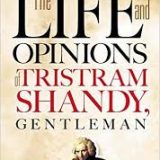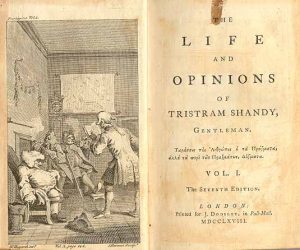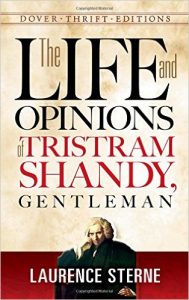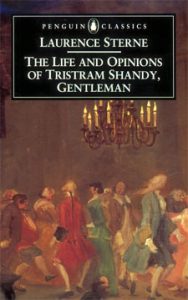
The Life and Opinions of Tristram Shandy – Laurence Sterne
The Life and Opinions of Tristram Shandy – Laurence Sterne – 1759

Reviewed by: Michael Sympson Date: 30 January 2002
 An uninformed reader may shy away from a slightly archaic diction and the blurb on the dust-cover. Sadly, he will never know what he is missing. But one doesn’t need to have a master’s degree to enjoy the fun with Sterne; he is intricate, but not obscure. A few footnotes regarding the more remote references and quotes can set things straight. Typically, no publisher bothers. Reading Sterne is a joy, not an exam. But of course there are conditions: A spot of intellectual maturity helps, though this bodes bad tidings in a popular culture as ours, which idolizes the prolonging of adolescence.
An uninformed reader may shy away from a slightly archaic diction and the blurb on the dust-cover. Sadly, he will never know what he is missing. But one doesn’t need to have a master’s degree to enjoy the fun with Sterne; he is intricate, but not obscure. A few footnotes regarding the more remote references and quotes can set things straight. Typically, no publisher bothers. Reading Sterne is a joy, not an exam. But of course there are conditions: A spot of intellectual maturity helps, though this bodes bad tidings in a popular culture as ours, which idolizes the prolonging of adolescence.
“Mr. Shandy, my father, Sir, would see nothing in the light in which others placed it; – he placed things in his own light; – he would weigh nothing in common scales; – no, he was too refined a researcher to lie open to so gross an imposition, – To come at the exact weight of things in the scientific steel-yard, the fulcrum, he would say, should be almost invisible, to avoid all friction from popular tenets; – without this the minutiae of philosophy, which would always turn the balance, will have no weight at all. Knowledge, like matter, he would affirm, was divisible in infinitum; – that the grains and scruples were as much a part of it, as the gravitation of the whole world. – In a word, he would say, error was error, – no matter where it fell, – whether in a fraction, – or a pound, – ’twas alike fatal to truth, and she was kept down at the bottom of her well, as inevitably by a mistake in the dust of a butterfly’s wing, – as in the disk of the sun, the moon, and all the stars of heaven put together” (Book 2, Chapter XIX).
Even critics of stature, as Dr. Johnson (1709-1784), could find themselves incapable of appreciating, what in their eyes merely seemed to be a cluttered mishmash of the odd and the weird: in 1776 the verdict was “”Nothing odd will do long. ‘Tristram Shandy’ did not last.” I wonder who might actually be reading Dr. Johnson these days … . (I recommend him, btw.) As for Lawrence Sterne’s book, it must have been put together with extreme care – how carefully, you can see from an innocent remark in Book 1, Chapter XXXII:
“… And I think, continued he, that the shock I received the year after the demolition of Dunkirk, in my affair with widow Wadman;–which shock you know I should not have received, but from my total ignorance of the sex, – has given me just cause to say, That I neither know nor do pretend to know any thing about ’em or their concerns either.”
Which appears to be just a loose piece of conversation, soon to be forgotten over other anecdotal matters and Uncle Toby’s and his valet’s hobby-horse (hornworks and curtains) but in fact ties the string for the climax of Uncle Toby’s story in Book IX, some 450 pages later.
So, all the ingredients in their proper measure are in place, like in the dough of a good pastry chef before the kneading. But then comes the moment when we place a raisin right in the center, roll over the dough and press with the heel of our hand, and do so again for a couple of times. “Chaos theory” tells us that at that stage it is no longer possible to predict the raisin’s actual position, even if we possess a perfect knowledge of all the initial parameter and have a grasp on the Newtonian math to calculate the outcome.
When reading over the first paragraph it appears Sterne had invented “chaos theory” and even the “butterfly effect” as a method for writing novels. He seemed to have succeeded. However there is probably not a single sentence which could pass as a random caprice. Especially when we consider the speed of publication – nine books, averaging some 60 pages each, from 1759 to 1767: in other words, this product of “whim and tomfoolery” took the author nine years to publish and five years to write – Sterne spent only two seasons of the year at the desk – by hand of course with quilt and inkwell. Even Gustave Flaubert (1821-1880) would produce more written copy in less time (100 pages a year). This raises a fair question:
L..d! said my mother, what is all this story about? – A Cock and a Bull, said Yorick – And one of the best of its kind, I ever heard.
Given the fact, that this is the final sentence and a verbatim quote from Rabelais’ last sentence (in Motteux’s translation) it is of course a deliberate declaration of artistic pedigree: Sterne is telling us with whom he wishes to be compared, or who, in his opinion, is the greatest writer in the eternal continuum of imaginative literature; greater even than Chervantes, who all over the book, receives more than one occasional nod of acknowledgement.o know what this book is all about we have to look somewhere else, to Book 2, Chapter VIII:
“… It is about an hour and a half’s tolerable good reading since my uncle Toby rung the bell, when Obadiah was ordered to saddle a horse, and go for Dr. Slop, the man-midwife;–so that no one can say, with reason, that I have not allowed Obadiah time enough, poetically speaking, and considering the emergency too, both to go and come;–though, morally and truly speaking, the man perhaps has scarce had time to get on his boots.
If the hypercritick will go upon this; and is resolved after all to take a pendulum, and measure the true distance betwixt the ringing of the bell, and the rap at the door; – and, after finding it to be no more than two minutes, thirteen seconds, and three-fifths, – should take upon him to insult over me for such a breach in the unity, or rather probability of time; – I would remind him, that the idea of duration, and of its simple modes, is got merely from the train and succession of our ideas – and is the true scholastic pendulum, – and by which, as a scholar, I will be tried in this matter, – abjuring and detesting the jurisdiction of all other pendulums whatever.
I would therefore desire him to consider that it is but poor eight miles from Shandy-Hall to Dr. Slop, the man-midwife’s house: – and that whilst Obadiah has been going those said miles and back, I have brought my uncle Toby from Namur, quite across all Flanders, into England: – That I have had him ill upon my hands near four years; – and have since travelled him and Corporal Trim in a chariot-and-four, a journey of near two hundred miles down into Yorkshire – all which put together, must have prepared the reader’s imagination for the entrance of Dr. Slop upon the stage, – as much, at least (I hope) as a dance, a song, or a concerto between the acts.”
In other words:- to his father’s great distress
“- the ideas of time and space – or how we came by those ideas – or of what stuff they were made – or whether they were born with us – or we picked them up afterwards as we went along–or whether we did it in frocks – or not till we had got into breeches–with a thousand other inquiries and disputes about Infinity Prescience, Liberty, Necessity, and so forth, upon whose desperate and unconquerable theories so many fine heads have been turned and cracked -” (Book 3 Chapter XVIII).
Yes, that’s right! It is all about time. It is at least as thorough a search for times past, as Marcel Proust’s “Recherche,” but infinitely more interesting, intricate, witty, malicious, and insidious. But to fully appreciate what the author is doing, I recommend to use a time table as your bookmark and take note of every incident and when exactly it was dated relative to the other incidents as well as in absolute, dull, old Newton time. You will notice that the widow Wadman affair is actually one of the most distant points in the past of the narrative “I” – long before Tristram’s birth; but in a strange way it gives closure to the protagonist’s own story. In a conservative piece of narrative this would be at the beginning of the book.
Time, Sternian time, is like a branching tree: every anecdotal turn creates a split between equally real but non-interactive alternatives. Taking on a life of their own, like Heraclit’s dreamer when he turns on his bed and shows a cold shoulder to the rest of the world, or like the interactions between Mr. and Mrs. Shandy, Tristram’s parents, which, in anticipation of Everett’s cosmology, no doubt, always end up in a split of worlds which remain mutually ignorant of each other, they continue to run along like non-euclidean diagonals hoping eventually to meet again in infinity. So the reader follows the author across the oceans, going places and travelling present, past and future – back and forth, north by north-west – and all the time the protagonists just sit in the parlor and waffle away over puffs of tobacco smoke, while Mrs. Shandy writhes in labor.
“It is two hours, and ten minutes – and no more – cried my father, looking at his watch, since Dr. Slop and Obadiah arrived – and I know not how it happens, Brother Toby – but to my imagination it seems almost an age” (Book 3 Chapter XIII).
 But eventually the protagonist has come to see the light, but to his father’s great distress, with a nose squashed in the process by Dr. Slope’s forceps. This is bad. Real bad. Not just for the poor babe, but it stirs unwelcome memories and continues a family tradition of … well what? The old Chinese gauged from a man’s thumb the length and strength of an organ further south. In the West – the old West – a man’s nose was expected to corelate to his codpiece. But what has the squeeze of a forceps in the babe’s face to do with anything? And why on Earth, does Mr. Shandy agree to have his son baptized by the one name, he hates most: “Tristram?” A question that starts niggling the reader from the very beginning – but for more than three whole books is never to be addressed again. (No worries. The man knows what he is doing.)
But eventually the protagonist has come to see the light, but to his father’s great distress, with a nose squashed in the process by Dr. Slope’s forceps. This is bad. Real bad. Not just for the poor babe, but it stirs unwelcome memories and continues a family tradition of … well what? The old Chinese gauged from a man’s thumb the length and strength of an organ further south. In the West – the old West – a man’s nose was expected to corelate to his codpiece. But what has the squeeze of a forceps in the babe’s face to do with anything? And why on Earth, does Mr. Shandy agree to have his son baptized by the one name, he hates most: “Tristram?” A question that starts niggling the reader from the very beginning – but for more than three whole books is never to be addressed again. (No worries. The man knows what he is doing.)
Sterne performs a truly astonishing trick: the whole novel, which appears to be all over the place is actually compressed or rather telescopically folded into the space of an afternoon in Mr. Shandy’s parlor. James Joyce has a reputation as a literary innovator for his time-management in Ulysses. Well Joyce himself knew jolly well that he wasn’t. He explicitly says so himself, in his typical fashion of confessing in foreign tongues – see the gatekeeper scene in “Finnegan’s Wake” and also the ditto opening paragraph. (Despite the mythological mummery it is simply a scene in reference to Joyce’s time in Triest, when his brother Stephen got hold of him at the door and interrogated him, before James would escape into the pubs for an other binge.)
What makes Sterne’s accomplishment so amazing is the way how the author manages to hide his slight of hand from the inattentive reader, especially from graduates in English Lit. The incidents in this novel are presented in a way that is not exactly part of the verbatim exchanges between the protagonists in the parlor; things do happen, without being confined to quotation marks and reams of stilted dialogue, as one would expect it from any run of the mill best-seller author. Never did an author know the rules so well, in order to break them all. Which still seems to be infuriating for students and professors of literature and creative writing alike.
A very talented scriptwriter might be able to catch one and the other of the many threads in this tightly woven tale – however it is my impression that on the silver screen every flashback weakens the overall immpact of any film using that ploy. But I am not complaining. In fact I am glad to note, that “Tristram Shandy” is living proof for the written word’s capacity to do things, no other medium could hope to emulate. In the beginning was the word, and it is with our species all the way to the end. (This is my bias; I am a writer.)
And of course, this is not an exercise in stream of consciousness and other modern or postmodern claptrap. Sterne is not a clairvoyant like Mr. Joyce and Company; the characters in Sterne’s Novel still need to actually tell each other what they think and feel. It is all about conscience of course – the way we think and what makes us tick, based on the absurd premise of John Locke (1632-1704) that we are born with minds in a state of tabula-raza. Mr. Shandy explains to his brother how time and conscience work according to the philosopher’s theory:
“To understand what time is aright, without which we never can comprehend infinity, insomuch as one is a portion of the other – we ought seriously to sit down and consider what idea it is we have of duration, so as to give a satisfactory account how we came by it.–What is that to any body? quoth my uncle Toby. (Vide Locke.) For if you will turn your eyes inwards upon your mind, continued my father, and observe attentively, you will perceive, brother, that whilst you and I are talking together, and thinking, and smoking our pipes, or whilst we receive successively ideas in our minds, we know that we do exist, and so we estimate the existence, or the continuation of the existence of ourselves, or any thing else, commensurate to the succession of any ideas in our minds, the duration of ourselves, or any such other thing co-existing with our thinking – and so according to that … in our computations of time, we are so used to minutes, hours, weeks, and months–and of clocks (I wish there was not a clock in the kingdom) to measure out their several portions to us, and to those who belong to us – that ’twill be well, if in time to come, the succession of our ideas be of any use or service to us at all.
Now, whether we observe it or no, continued my father, in every sound man’s head, there is a regular succession of ideas of one sort or other, which follow … and succeed one another in our minds at certain distances, just like the images in the inside of a lanthorn turned round by the heat of a candle. -I declare, quoth my uncle Toby, mine are more like a smoke-jack, – … .”
Speaking of which: what do we actually know about the author? Not much, really, despite the open daylight over a well documented life. Sterne had his appointment with destiny rather late in life and started publishing his novel at the age of 49. It brought him popularity and a new home, which he christened “Shandy Hall.” He enjoyed every bit of his sudden fame. So it strikes us as a bit strange that a writer of such calibre, allowed himself to be caught recycling his old love letters for new occassions. We know his last words; before Death stopped his heart, Sterne suddenly looked up and said “there it is!” His body was snatched from the grave only hours after the burial and a friend of his fainted in the operating theater when he saw the royal surgeon performing a post mortem on Sterne’s corpse.
If we must draw comparisons, it might be the easier task for a writer of talent to emulate the titanic gestures of a Beethoven. In the world of letters, Tolstoy took on Beethoven’s part and added a few more barbs to the overall picture. Being the earlier of the two, Lawrence Sterne on the other hand, presents a mind-set in empathy with Mozart’s blend of consummate ease, unassuming grace and gross obscenities. What a modern reader often fails to realize, is the author’s consummate familiarity with the conventions of an ancient art, the antique science of delivering a speech. Therefore even graduates and professors are prone to draw anachronistic parallels to the techniques of modern literature. Cicero’s Rhetorics are Sterne’s point of reference, linguistically and formally.
In his day and age, Sterne still could trust it to be a rather common fare for the educated reader as well. But nothing of this seems to cloud the sunny day of latter day ignorance in the minds of professors and students under the sway of “deconstruction” and “postmodernism.” Therefore we just know it must be crap because the Pavlovian conditioning of our 30 second attention span makes us screaming for the commercial break, before Sterne would finish even one sentence. Not that this novel is entirely free of flaws. If nitpick we must, it is easy to point the finger at Sterne’s shortcomings when it comes to nature and a grand cosmological perspective. Tolstoy was not the only writer who did better in this department.
So even Sterne left space for improvements: his landscapes are practically non-existent, Nature comes in the shape of French gardens with shrubs trimmed down to form geometrical brain teasers; the visuals are almost all the time close-ups and portrait shots; vivid enough but not a picture of God’s plenty. People in Sterne’s book talk and think, most of the time, they don’t move around a lot.
© – 7/31/2002 – by Michael Sympson – all rights reserved














